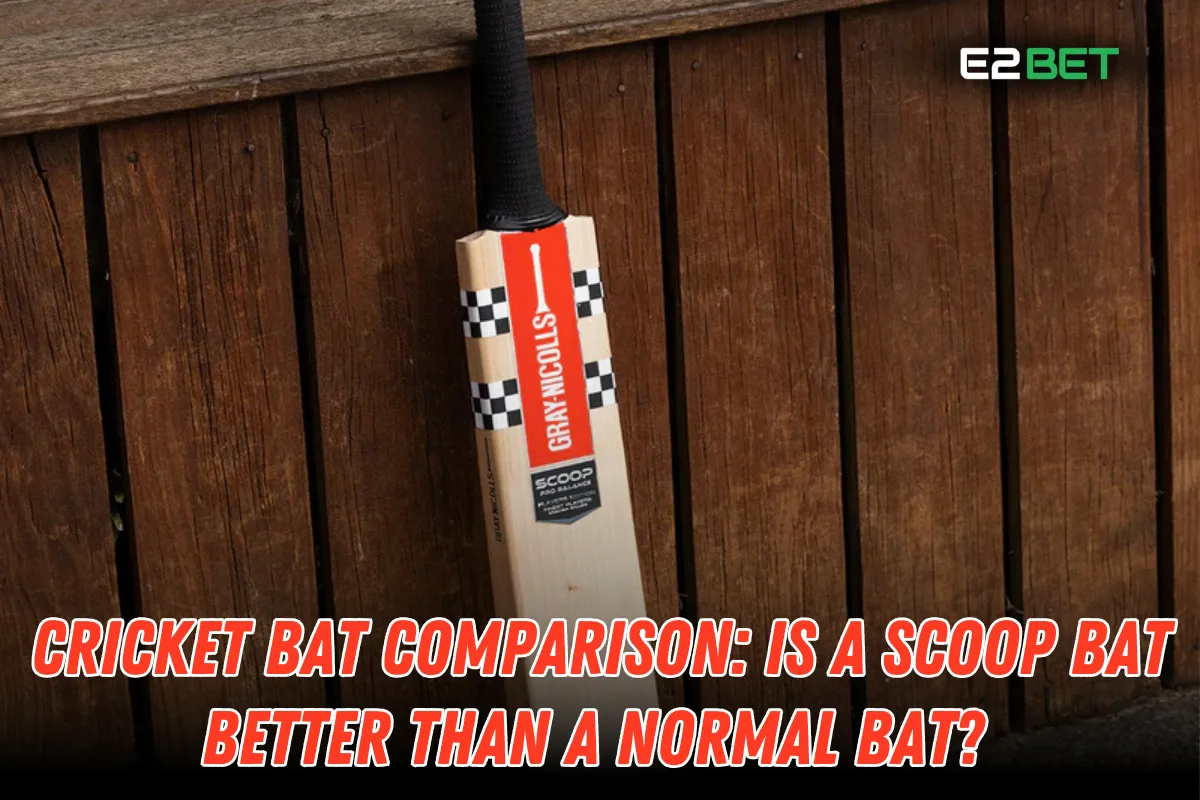Cricket is a sport where every detail matters, and choosing the right cricket bat can significantly impact a player’s performance. Whether you’re an aspiring cricketer or a seasoned player, selecting between a scoop and a normal bat is a common dilemma. Scoop Bat vs. Normal Bat, Some believe that lightweight cricket bats for stroke play offer better shot control, while others prefer the raw power of a traditional bat. But which one is better?
In this guide, we’ll compare scoop bats vs. normal bats, discussing their advantages, disadvantages, and best use cases to help you make an informed decision.
Understanding Cricket Bats
Components of a Cricket Bat
A cricket bat consists of several key parts:
- Handle – Offers grip and control for precise shots.
- Blade – The flat surface used to strike the ball.
- Spine – The central ridge at the back of the bat, affecting balance and power.
- Edges – The sides of the bat, influence stroke power and durability.
Materials Used in Cricket Bats
Most high-quality cricket bats are crafted from English willow, known for its superior performance. However, Kashmir willow cricket bats are also popular, especially among beginners due to their affordability.
What is a Scoop Bat?
History and Origin of Scoop Bats
Gray-Nicolls first introduced the scoop bat in the 1970s. It was designed to reduce weight while maintaining power, making it easier for players to generate quick bat speed.
Design Features of a Scoop Bat
A scoop bat features a hollowed-out back, which removes excess wood without affecting the sweet spot. This allows for a lighter pickup while maintaining effective stroke play.
Advantages of a Scoop Bat
- Lightweight Design – Ideal for stroke players who rely on finesse rather than brute force.
- Better Pickup and Balance – Helps in quick reflex shots, especially in T20 and ODI formats.
- Increased Bat Speed – A lighter bat enables faster hand movements, making it easier to play wristy shots.
Disadvantages of a Scoop Bat
- Reduced Power – The lack of a full spine means it doesn’t generate as much power as a traditional bat.
- Durability Concerns – A scoop bat has a weaker structure, making it less durable than a normal bat.

What is a Normal Cricket Bat?
Traditional Bat Design and Features
A normal bat, also known as a traditional bat, has a solid back with a full spine, providing greater stability and power.
Advantages of a Normal Bat
- More Power for Hitting Sixes – The full-back structure allows for stronger shots, making it perfect for power hitters.
- Greater Durability – A normal cricket bat lasts longer, making it an excellent investment for professional players.
Disadvantages of a Normal Bat
- Heavier Compared to Scoop Bats – Requires more strength and wrist control to play quick shots.
- Slower Bat Speed – A normal bat may not be as fast as a scoop bat in stroke play.
Scoop Bat vs. Normal Bat – A Detailed Comparison
Weight and Balance
- Scoop Bat – Lightweight cricket bat, easier to swing.
- Normal Bat – Heavier, but provides more control.
Power and Stroke Play
- Scoop Bat – Best for T20 cricket and fast-paced innings.
- Normal Bat – Ideal for Test cricket where stability is key.
Durability and Longevity
- Scoop Bat – Less durable due to the scooped-out structure.
- Normal Bat – Lasts longer with proper maintenance.
Suitability for Different Formats
- Scoop Bat – Great for T20 and ODI cricket, where bat speed is essential.
- Normal Bat – Suitable for Test cricket, providing better control for longer innings.
Player Preferences
Legendary cricketers like Kapil Dev have used scoop bats, while modern-day power hitters like MS Dhoni and Chris Gayle prefer normal bats for their power-hitting capabilities.
Which Bat Should You Choose?
Factors to Consider When Buying a Cricket Bat
- Playing Style – If you’re a stroke player, a scoop bat might be the better choice. However, if you rely on power-hitting, a normal bat will serve you better.
- Strength & Fitness – A normal bat requires stronger arms, while a scoop bat is easier to maneuver.
- Match Format – If you play mostly T20 or ODI cricket, a scoop bat might be beneficial. But for longer formats, a normal bat is ideal.
Recommendations for Different Players
- Beginners & Young Players – Scoop bats are great due to their lightweight structure.
- Professional Players – A normal bat provides better power and longevity.
Conclusion
Both scoop bats and normal bats have their strengths and weaknesses. If you prefer quick wristy shots and faster bat speed, a scoop bat could be the right choice. However, if you need powerful sixes and durability, a normal bat is your best bet. Ultimately, your playing style and format will determine which bat suits you best.
FAQs
1. What makes a scoop bat different from a normal bat?
Ans: A scoop bat has a hollowed-out back, making it lighter and easier to handle. In contrast, a normal bat has a solid spine, providing more power.
2. Can a scoop bat be used in professional cricket?
Ans: Yes, but most professional cricketers prefer normal bats because of their power and durability.
3. Which bat is better for hitting sixes?
Ans: A normal bat is better for hitting sixes because of its solid structure and thicker edges.
4. Are scoop bats more expensive than normal bats?
Ans: Not necessarily. The price of a cricket bat depends on factors like brand, willow quality, and craftsmanship.
5. How do I maintain my cricket bat for long-lasting performance?
Ans: Keep your bat oiled and stored in a dry place. Avoid using it on wet pitches. Regularly check for cracks and apply anti-scuff sheets if needed.